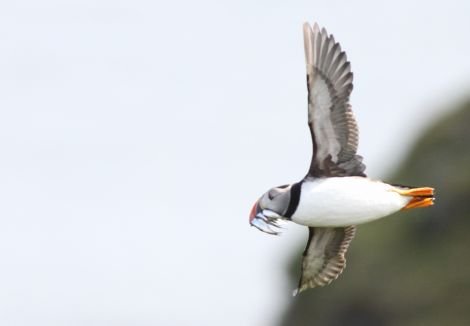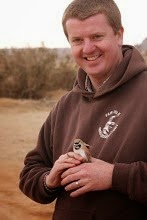News / Hopes high for Shetland’s seabird chicks
SHETLAND’S seabirds are showing signs of enjoying their best season for several years heartening ornithologists worried about their long term wellbeing.
Puffins, arctic terns, guillemots, shags, kittiwakes and razorbills all appear to be feeding well on abundant shoals of sandeels and sillocks around the isles.
While monitoring last year showed Shetland seabirds flying hundreds of miles to bring food back to their chicks, this year they are feeding well within a 20 mile radius of the islands.
Sumburgh-based ornithologist Martin Heubeck, who runs the seabird monitoring programme for environment group SOTEAG, said 2014 was “radically different from last year, which was about as bad as it gets”.
Shetland’s world famous seabird populations have been on a steady decline for the past 30 years due to food shortages, for which climate change is now being blamed rather than overfishing.
The past three years had been some of the worst on record with talk of some species disappearing from the islands altogether.
With Shetland’s tourist industry largely based on its wildlife attractions, the trend threatens to have considerable economic impact, especially on a small island like Fair Isle, which relies on birdwatching holidaymakers to sustain itself much of the year.
Fair Isle Bird Observatory (FIBO) warden for the past four years, Dave Parnaby, said this is the first time he feels like he is experiencing anything like what he has heard of the island’s bird life in the past.
“Last year was quite depressing working in the colonies and finding birds that had not even bothered to breed,” he said.
“This year it’s looking so much better. A few nights ago it was calm, the moon was out and you could listen to the calls of the guillemot chicks, which is how I always imagined Fair Isle should be.
Become a supporter of Shetland News
“I have heard lots of stories about what it was like with the noise and the smell, but this is the first time I have heard and smelt it myself.”
To give an idea of how much things have improved, in the past three years the FIBO team had only managed to find 23 guillemot chicks that were strong enough to ring. This year they have already managed to ring more than 300.
This still falls way short of the figures in the 1980s when some years saw more than 2,000 chicks ringed, but it is a step towards stemming the decline.
“These birds don’t need to have a successful year every year they are so long-lived, so if they can do this once every few years that could be enough to get the population back on its feet,” Parnaby said.
Last year birds were subsisting on tiny fish they were flying enormous distances to find, sometimes leaving the nest for up to five days. Monitoring showed them feeding as far away as the waters off Dundee.
When they returned there was such hunger in the colonies that birds would fight over the scraps. Food was so short that many pairs did not even bother to breed.
“Guillemots were food stressed from the start last year,” Heubeck recalled.
“The scale of non breeding was pretty high, birds were not finding food within reasonable foraging range, eggs were abandoned and the birds were extremely nervous.
“There was a lot of fighting and the hatching rate of first eggs was the lowest on record at 11 per cent. This year it’s 66 per cent for guillemots.
“This year there has been absolutely no fighting whatsoever, the colonies are much more settled and calm.”
The reason is a plentiful supply of both sandeels and sillocks in Shetland waters. Heubeck says that sillocks are now the most abundant food source around Sumburgh, while on Fair Isle birds are returning with good-sized sandeels measuring 10cm or more, the likes of which have not been seen for many years.
However it is too early to be certain that all the seabirds will do well this year, with species such as arctic tern and the much-adored puffin chicks still weeks away from fledging.
Helen Moncrieff, local officer with bird charity RSPB, said there was “a peerie glimmer of hope”.
“It feels like a more promising year this year, but we still have to wait and see if the birds fledge so we will continue to monitor before we can really comment,” she said.
On Fair Isle they want to do more than wait and have spent the past 25 years campaigning to have the waters around the island designated as a marine protected area (MPA) to carry out research into what is happening out at sea.
Nick Riddiford, who coordinates the Fair Isle Marine Environment and Tourism Initiative (FIMETI), said the health of the seabirds was crucial for the island that is now more dependent upon birdwatchers than fishing.
“Seabirds are of major socio-economic importance to us,” he said.
“We have just had a series of German bird watching groups visiting over the last few weeks and they had a wonderful experience, mainly watching the puffins.
“The island gets very anxious when we see seabirds under stress. We felt we could lose them in the long term so we asked what we could do about it.”
The answer is a protected area around the islands where research can be carried out into the state of the marine environment and experiments made with fishing gear designed to avoid catching small fish.
“The idea is to avoid taking smaller fish, which are not only food for the seabirds but the commercial fish of the future.
“It makes no sense to take out the commercial fish of the future before they have reached commercial size.”
The move has the support of the entire island community, the local fishing industry and the full backing of the Council of Europe, representing 47 states.
In 1985 the Council of Europe made Fair Isle one of just two places in Scotland and 70 in Europe to be awarded a diploma for its pristine environment. Next year the island faces the threat of that diploma being removed unless the Scottish government introduces the MPA.
Research around Fair Isle might help us understand what lies behind the sudden changes in fish populations that then impact on bird life.
But it will take more than one successful year of plentiful fish for Shetland’s much-loved seabirds to reach the levels when they could darken the sky with their numbers.
Become a supporter of Shetland News
Shetland News is asking its many readers to consider start paying for their dose of the latest local news delivered straight to their PC, tablet or mobile phone.
Journalism comes at a price and because that price is not being paid in today’s rapidly changing media world, most publishers - national and local - struggle financially despite very healthy audience figures.
Most online publishers have started charging for access to their websites, others have chosen a different route. Shetland News currently has over 600 supporters who are all making small voluntary financial contributions. All funds go towards covering our cost and improving the service further.
Your contribution will ensure Shetland News can: -
- Bring you the headlines as they happen;
- Stay editorially independent;
- Give a voice to the community;
- Grow site traffic further;
- Research and publish more in-depth news, including more Shetland Lives features.
If you appreciate what we do and feel strongly about impartial local journalism, then please become a supporter of Shetland News by either making a single payment or monthly subscription.
Support us from as little as £3 per month – it only takes a minute to sign up. Thank you.









